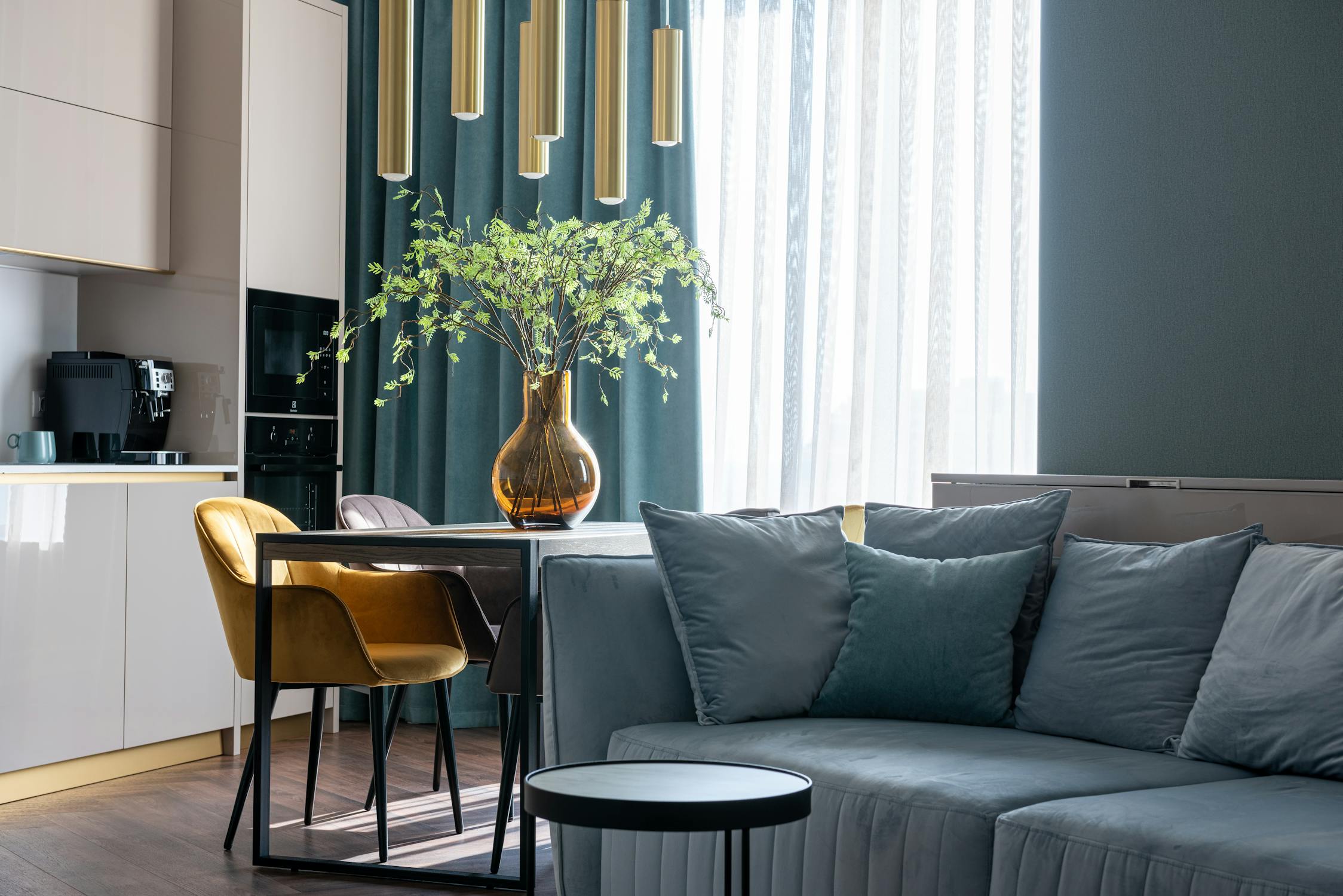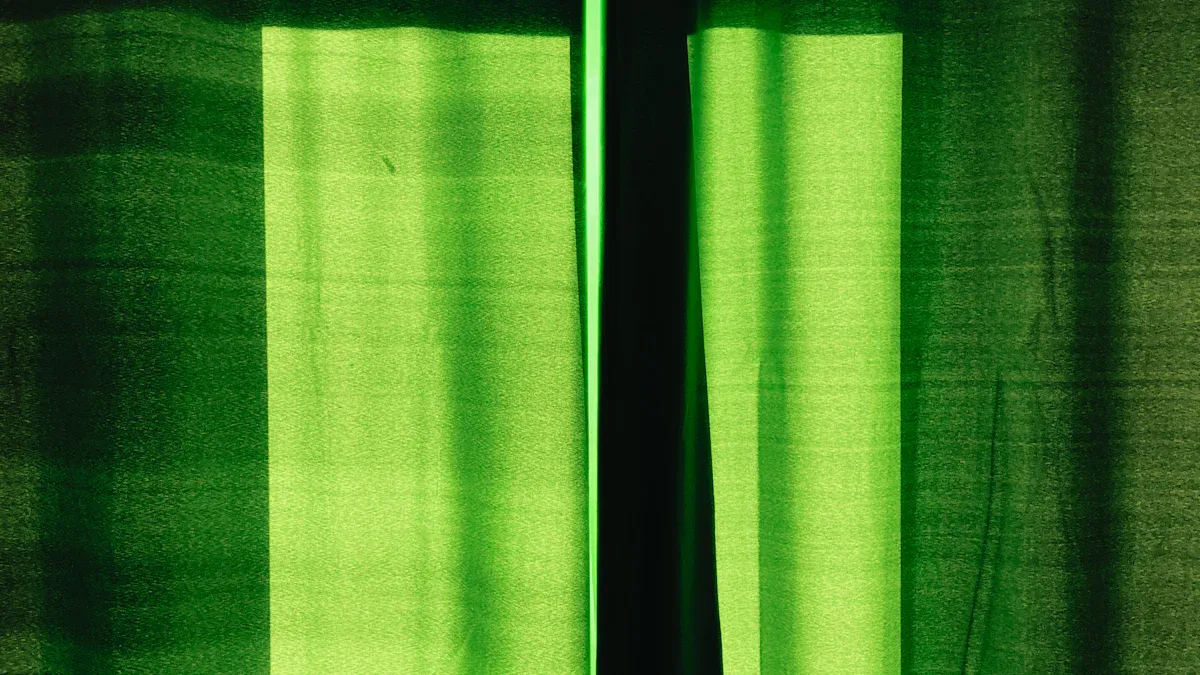
Eco-Friendly Fabrics for Custom Curtains: 6 Sustainable Choices You’ll Love

Choosing eco-friendly curtains for your home is crucial for a sustainable lifestyle. These eco-friendly curtains not only contribute to environmental well-being but also enhance your home's aesthetic appeal. Many consumers now prefer custom linen curtains made from sustainable materials due to their unique benefits. These linen curtains offer natural texture and durability, making them a popular choice in high-end home décor. In fact, the demand for custom curtains is rising as people seek personalized solutions that align with eco-friendly values. You'll love the six sustainable fabric options we explore, each combining style, functionality, and environmental responsibility.
34% of respondents find natural elements and biomaterials highly relevant.
35% of respondents rate eco-chic and sustainable-chic as highly relevant.
30% of European households are actively looking to improve energy efficiency within their homes.
Proper window treatments can lower heating costs by up to 25% during winter months.
The growing consumer preference for sustainable and biodegradable materials is a significant factor driving the linen market, indicating a shift towards eco-friendly home textiles.
Linen's natural texture and durability make it a favored option for high-end home décor, including curtains, which enhances its appeal in the market.
The hospitality industry increasingly opts for linen products due to their luxurious feel and ease of maintenance, further validating the demand for linen curtains in various settings.
Key Takeaways
Picking eco-friendly curtains helps the planet and looks great.
Choose fabrics like organic cotton, linen, or hemp for strength and beauty.
Check for eco-certifications to make sure they are safe and green.
These curtains keep indoor air cleaner by avoiding harmful chemicals.
Energy-saving curtains can cut heating bills by 25% in winter.
Why Eco-Friendly Curtains Matter

Environmental Impact of Sustainable Fabrics
Choosing eco-friendly curtains for your home significantly reduces your environmental footprint. These curtains, made from sustainable materials like organic cotton and recycled polyester, offer numerous benefits:
They reduce environmental impact by using fewer resources during production.
They enhance insulation, leading to lower energy bills and a reduced carbon footprint.
Natural materials improve indoor air quality, contributing to a healthier home environment.
A report titled "Life cycle assessments for textile and fashion products" highlights the importance of sustainable fabrics. It emphasizes the role of life cycle assessments (LCA) in measuring environmental impacts throughout a product's life cycle. EU regulations promote sustainability and require LCAs for transparency.
Health Benefits of Eco-Friendly Materials
Eco-friendly curtains not only benefit the environment but also your health. By using natural and sustainable materials, these curtains help maintain healthier indoor air quality. They minimize the presence of harmful chemicals often found in conventional curtains. This reduction in toxins creates a safer living space for you and your family. Additionally, the use of sustainable choices in your home can lead to improved well-being and comfort.
Aesthetic Appeal of Custom Linen Curtains
Custom linen curtains are a popular choice in modern interiors due to their aesthetic appeal. They enhance the overall look of a space with their luxurious feel and high-quality materials. The trend towards personalization allows you to tailor these curtains to your specific design preferences, making them a unique element in your home. Linen's natural texture and durability make it a favored option for those seeking sustainable choices in home decor. By opting for custom curtains, you can achieve a stylish and eco-friendly look that complements your interior design.
6 Sustainable Fabric Choices for Custom Curtains

Organic Cotton: A Soft and Versatile Option
Organic cotton stands out as one of the most popular organic fabrics for custom curtains. Its soft and fluffy texture makes it a comfortable choice for your home. This fabric adapts effortlessly to various interior styles, whether you prefer a casual or formal look. Organic cotton curtains bring a natural charm to your space while aligning with sustainable choices.
Unlike conventional cotton, organic cotton uses fewer chemicals during production. This reduces its environmental impact and makes it a healthier option for your home. By choosing organic cotton curtains, you support sustainable materials that promote eco-friendly living.
Did you know? Organic cotton is not only soft but also durable, ensuring your curtains last longer while maintaining their elegance.
Linen: Durable, Stylish, and Eco-Friendly
Linen is a timeless favorite for sustainable curtains. Its durability and natural texture make it a standout choice for eco-conscious homeowners. Linen is three times stronger than cotton, ensuring your curtains withstand daily use without losing their charm. With proper care, linen curtains can last for decades, reducing textile waste and saving you money in the long run.
This fabric also has a minimal environmental footprint. Linen production requires 60% less water than cotton and relies on naturally pest-resistant flax plants. This means fewer pesticides and a more sustainable process overall. Additionally, linen is fully biodegradable, making it one of the most sustainable choices for your home.
Linen curtains offer practicality and elevate interior design. Their natural resistance to stains and bacteria ensures they remain fresh and beautiful with minimal maintenance.
Hemp: A Strong and Sustainable Choice
Hemp is another excellent option for sustainable curtains. Known for its strength and durability, hemp fabric can handle wear and tear while maintaining its quality. This makes it ideal for high-traffic areas in your home. Hemp curtains also have a unique texture that adds character and warmth to your living space.
As one of the most eco-friendly organic fabrics, hemp grows quickly and requires minimal water and pesticides. Its production process has a low environmental impact, making it a top choice for sustainable materials. Hemp curtains also provide excellent insulation, helping you regulate indoor temperatures and reduce energy consumption.
By choosing hemp, you invest in sustainable choices that benefit both your home and the planet.
Bamboo: Lightweight and Renewable
Bamboo fabric is an excellent choice for custom curtains due to its lightweight nature and sustainability. This fabric, derived from bamboo plants, offers a unique combination of functionality and style. Its breathable properties make it ideal for maintaining a comfortable indoor environment. Bamboo curtains also provide effective sunlight protection, helping to regulate room temperature while reducing glare.
The renewable nature of bamboo makes it a standout option among sustainable fabrics. Bamboo grows rapidly, often reaching maturity within three to five years. This quick growth rate ensures a consistent supply without depleting natural resources. Additionally, bamboo cultivation requires minimal water and no pesticides, further enhancing its eco-friendly appeal.
Bamboo curtains bring a natural aesthetic to your home decor. Their soft texture and subtle sheen add elegance to any room. Whether you prefer a modern or rustic look, bamboo fabric adapts seamlessly to various interior styles. By choosing bamboo, you not only elevate your home’s design but also contribute to a more sustainable future.
Recycled Polyester: Reducing Waste with Style
Recycled polyester is a game-changer in the world of sustainable curtains. This fabric, made from recycled materials like plastic bottles, helps reduce waste while offering a stylish and durable option for your home. Its production process saves nearly 80% of energy compared to virgin polyester, making it a more sustainable choice.
The environmental benefits of recycled polyester are significant. Producing one ton of this fabric saves one ton of oil and six tons of water. Additionally, its use contributes to low-carbon emission goals, aligning with global efforts toward sustainable development. By incorporating recycled materials into your home, you actively support these initiatives.
Recycled polyester curtains are not only eco-friendly but also versatile. They come in a variety of colors and patterns, allowing you to customize your space effortlessly. Their durability ensures they maintain their appearance over time, making them a practical and stylish addition to your home.
Tencel (Lyocell): A Modern, Sustainable Fabric
Tencel, also known as Lyocell, represents the future of sustainable fabrics. Made from cellulose derived from wood pulp, this fabric is biodegradable and produced using eco-friendly processes. Its closed-loop production system minimizes water and chemical waste, setting a high standard for sustainability.
Feature |
Description |
|---|---|
Production Technology |
Continuous advancements improve efficiency, quality, and cost-effectiveness. |
Environmental Impact |
Biodegradable and produced using eco-friendly processes, including a closed-loop system. |
Innovative Applications |
LENZING™ Lyocell Dry enhances moisture management and degrades in marine environments. |
Tencel curtains offer a luxurious feel and excellent moisture management. Their smooth texture and natural drape make them a favorite for modern interiors. Innovations in Tencel production have expanded its applications, allowing for unique blends that enhance its functionality. By choosing Tencel, you invest in a fabric that combines style, comfort, and sustainability.
How to Choose the Right Eco-Friendly Fabric
Assess Durability and Maintenance Needs
When selecting eco-friendly curtains, durability and maintenance should be top priorities. You want fabrics that can withstand daily use while maintaining their quality over time. Certain materials, like linen and hemp, are known for their strength and longevity. Linen, for instance, is three times stronger than cotton, making it an excellent choice for long-lasting custom curtains. Hemp, on the other hand, resists mold and wear, ensuring your curtains remain in great condition for years.
Industry tests, such as tensile strength and abrasion tests, help evaluate a fabric's durability. For example, tensile strength tests measure how much force a fabric can endure before breaking, while abrasion tests simulate real-world wear and tear. These assessments ensure that the fabric you choose meets high-quality standards. Additionally, consider maintenance needs. Some fabrics, like bamboo and recycled polyester, are easy to clean and require minimal upkeep, making them practical for busy households.
Tip: Opt for fabrics with proven durability and low-maintenance requirements to enjoy both style and functionality in your home.
Match the Fabric to Your Home’s Style
Your curtains should complement your home’s overall aesthetic. Matching fabric textures and colors to your interior design creates a cohesive and inviting space. Textured materials, such as linen or bamboo, add depth and character to your decor. Linen’s natural texture pairs beautifully with minimalist or rustic styles, while bamboo’s soft sheen suits modern interiors.
Color selection also plays a crucial role. Seasonal color analysis can guide you in choosing shades that harmonize with your home’s palette. For instance, warm tones like terracotta or mustard work well in autumn-inspired spaces, while cool blues and greens enhance a summer-themed room. Customizable options allow you to tailor your curtains to your specific design preferences, ensuring they align perfectly with your vision.
Note: Incorporating textured fabrics and seasonal colors can elevate your home’s style effortlessly.
Consider Light Filtering and Insulation
Curtains do more than enhance your home’s appearance; they also serve functional purposes like light filtering and insulation. Fabrics like organic cotton and Tencel offer excellent light-filtering properties, allowing natural light to brighten your space while maintaining privacy. Bamboo and hemp, known for their insulating qualities, help regulate indoor temperatures, reducing energy consumption and creating a comfortable environment.
Thermal conductivity tests assess a fabric’s ability to insulate against heat, making it easier to choose materials that improve energy efficiency. For instance, hemp curtains provide superior insulation, keeping your home warm in winter and cool in summer. By selecting fabrics with these features, you can enjoy a sustainable and energy-efficient living space.
Did you know? Properly insulated curtains can lower heating costs by up to 25% during winter months.
Look for Sustainability Certifications
When selecting eco-friendly fabrics for your custom curtains, sustainability certifications play a crucial role. These certifications help you identify materials that meet environmental and health standards. By choosing certified fabrics, you ensure that your curtains align with your commitment to sustainability and safety.
Sustainability certifications verify various aspects of a fabric's production, such as its environmental impact, chemical safety, and recycled content. For example, certifications like Oeko-Tex and REACH test textiles for harmful substances, ensuring they are safe for indoor use. Others, like the Global Recycled Standard, validate the use of recycled materials and responsible manufacturing practices. These certifications provide transparency, helping you make informed decisions.
Here’s a quick guide to some of the most reliable sustainability certifications for curtain fabrics:
Certification Name |
Description |
|---|---|
Forest Stewardship Council (FSC) |
Certifies sustainable harvesting of wood-based materials. |
Greenguard® and Greenguard Gold® |
Verifies low chemical emissions for better indoor air quality. |
Greenscreen Certification |
Confirms exclusion of harmful chemical groups like PFAS. |
Global Recycled Standard |
Validates recycled content and responsible practices. |
Oeko-Tex Certification |
Tests textiles for harmful substances. |
REACH |
Regulates chemical safety in the EU. |
Cradle to Cradle Certification |
Evaluates products based on multiple sustainability criteria. |
EU Ecolabel Certification |
Awarded for meeting ecological criteria through lifecycle analysis. |
Facts Certification |
Assesses sustainability of commercial fabrics based on environmental issues. |
These certifications not only ensure the quality of your curtains but also contribute to a healthier home environment. For instance, Greenguard-certified fabrics reduce chemical emissions, improving indoor air quality. Similarly, FSC-certified materials promote sustainable forestry, protecting natural ecosystems.
Tip: Look for labels from trusted organizations when shopping for eco-friendly curtains. Certifications like Oeko-Tex or Cradle to Cradle provide peace of mind, ensuring your choices are both stylish and sustainable.
By prioritizing certified fabrics, you support ethical practices and reduce your environmental footprint. This small step can make a big difference for your home and the planet.
Choosing eco-friendly curtains for your home is a step toward creating an eco-conscious home. Each of the six sustainable fabric options—organic cotton, linen, hemp, bamboo, recycled polyester, and Tencel—offers unique benefits. These materials combine durability, style, and environmental responsibility, making them ideal for custom curtains. By selecting these fabrics, you reduce your environmental impact while enhancing your home’s comfort and design.
Support sustainable brands like Freshine to find custom curtains that align with your values. Their Celina Linen Curtains provide an elegant and functional solution for your home. Start your journey toward a greener lifestyle today by making eco-friendly choices that benefit both your home and the planet.
FAQ
What are eco-friendly curtains made of?
Eco-friendly curtains are crafted from sustainable materials like organic cotton, linen, hemp, bamboo, recycled polyester, or Tencel. These fabrics minimize environmental impact by using fewer resources and avoiding harmful chemicals during production.
How do eco-friendly curtains improve indoor air quality?
Eco-friendly curtains avoid toxic chemicals found in conventional fabrics. By using natural or certified materials, they reduce indoor air pollutants, creating a healthier living environment for you and your family.
Are eco-friendly curtains durable?
Yes, eco-friendly curtains are highly durable. Fabrics like linen, hemp, and recycled polyester resist wear and tear, ensuring long-lasting performance. Their strength makes them a practical and sustainable choice for your home.
Can eco-friendly curtains help save energy?
Eco-friendly curtains enhance insulation, reducing heat loss in winter and blocking heat in summer. Materials like hemp and bamboo provide excellent thermal regulation, helping you lower energy consumption and utility bills.
Where can I find custom eco-friendly curtains?
You can find custom eco-friendly curtains from sustainable brands like Freshine. Their Celina Linen Curtains offer a stylish and functional solution, combining elegance with environmental responsibility.










